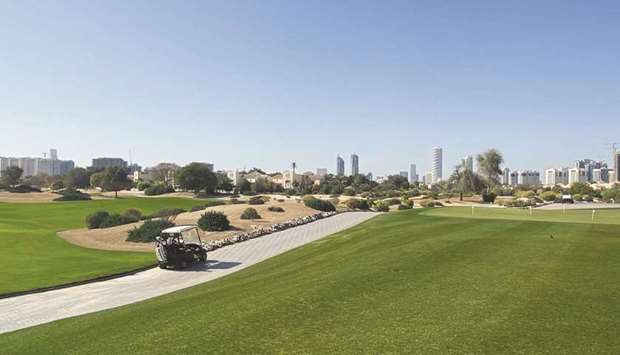Prime Dubai properties have been snapped up in the past few months by buyers taking advantage of decade-low prices, easy financing and an economy open for business despite the pandemic.
Sales of luxury villas, sea-view apartments and second-hand family houses have jumped, re-energising a property market that saw a sharp fall in activity at the height of the pandemic and had been in a five-year slump prior to that.
But with rents still falling and oversupply weighing, the road to recovery will be long for one of the emirate’s main economic engines.
Dubai’s economy – reliant on trade, tourism and its reputation as a regional hub for business services – was hard hit by the Covid-19 pandemic last year as firms slashed jobs.
Many foreign workers, needed to support demand in a real estate sector that contributed 7.2% of GDP in 2019, left.
Yet market activity has picked up in the last six months, after lockdowns and curfews were lifted, estate agents say, helping to stabilise prices for family villas and high-end beach and golf course properties.
Realtor Matthew Bate, whose agency Nest deals mainly in high-end villas, says business has become much busier in the past few months as nationals, residents and foreign visitors took the opportunity to buy.
“We did have some distressed assets coming out of the Covid-19 lockdown. Now I would say we are back up into early 2020, 2019 prices,” he said.
While much of the world re-imposed coronavirus restrictions this winter tourist season, Dubai welcomed visitors and the UAE started one of the world’s fastest vaccination campaigns.
“We had a huge influx of tourists...it exposed a lot of people to Dubai... The last 2-3 clients we had, dealing with properties over 15mn AED ($4.08mn), they have properties in New York, London and they are now looking at Dubai,” he said.
Still, while prices of high-end villas have stabilised, apartment prices as a whole in the emirate were mostly still falling in February, a price index by ValuStrat shows.
S&P credit analyst Sapna Jagtiani does not expect Dubai’s real estate market to recover to pre-pandemic levels until some time next year.
“Prices are down by 40%-50% from the last peak (2014)...this is why we think a recovery in prices to similar levels will be slow and long,” she said.
Rents at the end of 2020 were about 5%-10% lower than the market’s last trough a decade ago, Jagtiani said.
Even before the pandemic, the long-term economic trend in the UAE had been sluggish since the 2014-2015 oil price crash, said Christopher Payne, chief economist at Peninsula Real Estate, a UAE-based investment and research company.
“Lower oil prices are also feeding through to population numbers; you have to cut costs, people get laid off and people leave the country,” he said.
Low prices, relaxed mortgage conditions and a desire for more spacious properties as the pandemic jump-started working from home, have driven secondary market sales transactions in Dubai to record highs every month since September, said Lynette Abad of Property Finder Group, a real estate search portal.
The dominance of secondary transactions marks a fundamental market shift for Dubai.
Off-plan sales from new projects used to dominate, but several developers slowed or halted new projects last year.
They included Emaar Properties’ Dubai Creek Harbour, a luxury development of waterfront apartments designed to house 200,000 people, sources told Reuters last April.
Dubai’s hosting of the Expo 2020 world fair, due to take place in October after being postponed because of the pandemic, as well as a recent series of measures to relax long-term visa and citizenship rules, should boost market sentiment in the medium- to long-term, analysts say.
But despite optimism over rising demand for certain sectors of the market, oversupply remains a key problem.
For years supply has outpaced demand for new houses and apartments in a market where most of the population are foreigners.
“The supply-demand imbalance is likely to worsen over the course of 2021. This will result from rising levels of supply, particularly over the next 12-18 months, and increasingly curtailed demand as businesses and employees navigate through downsizing and ultimately repatriation of unemployed workers,” Asteco, a real estate services company, said in a report.
New supply forecasts for 2021 vary.
Real estate consultancy Knight Frank sees “historic levels” of new supply coming online this year, at around 83,000 residential units in Dubai, up from 35,808 last year, while Asteco expects around 41,500 this year, up from its estimate of around 34,050 in 2020.
“Some market indicators will look better in 2021...(like) growth in mortgage buying in Dubai, etc.... But will it trigger recovery? Maybe not by itself. We think the main aspect that would trigger recovery is cutback on supply,” Jagtiani said.
Cutbacks to new projects have hurt developers’ bottom lines.
Emaar, Dubai’s largest listed developer, reported a 58% fall in net profit last year and rival DAMAC Properties made a net loss of 1.04bn dirhams ($283.16mn).
“There are multiple stresses on developers, mainly to manage liquidity and cash flow while making timely deliveries, additionally pre-sales may not be very encouraging in 2021 and mostly you’ll see reduced profit and higher leverage,” Jagtiani said.
A wave of restructurings swept the industry and some developers went bust in the years following the 2008 financial crisis.
Signs of further restructuring and consolidation are emerging, including Emaar planning a takeover and delisting of its malls unit, and state-linked Meraas Holding being brought under the investment vehicle of the emirate’s ruler, Dubai Holding.
“Developers with stronger balance sheets will have higher chances of survival than smaller ones as market share will shift to developers offering the most flexible payment plans. It is difficult for small developers to address affordability concerns,” Mohamad Haidar of Arqaam Capital said.

A general view of the Victory Heights golf course villa community in Dubai on March 4. With rents still falling and oversupply weighing, the road to recovery will be long for one of the emirate’s main economic engines.


